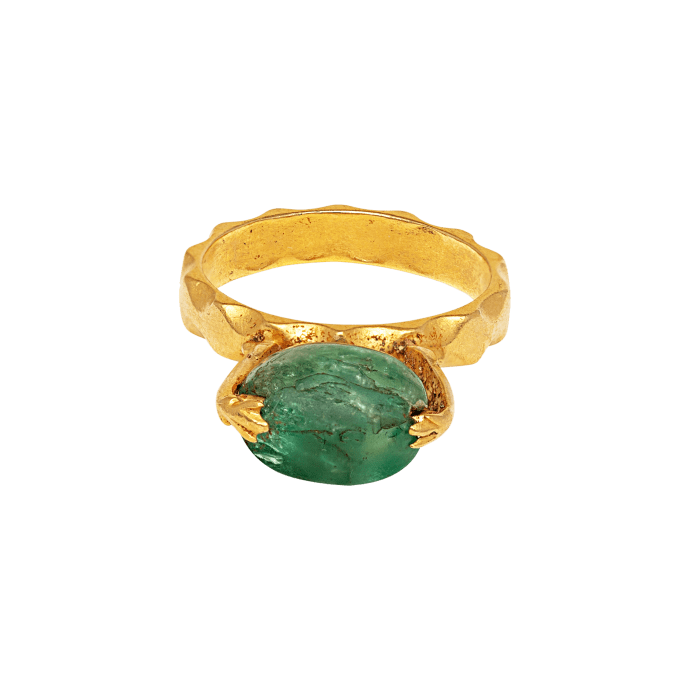


Emerald ring with dolphins
, Romano-Egyptian, 3rd century AD



Emerald ring with dolphins
Description
Striking Roman-Egyptian ring, with Cleopatra's favorite gemstone
Gold ring with slender hoop, plain on the interior and scalloped on the exterior. The bezel is formed of two dolphins with upright tails supporting an elliptical-shaped emerald bead on a swivel setting. The ring is in good wearable condition.
Provenance:
Provenance: Collection of Michael O'Hara, acquired 1968; Private collection, London, acquired prior to 1991, and thence by descent
Literature:
In Roman times emeralds were hugely popular and worn by women, as can be found in surviving jewels and on the beautifully rendered Fayum mummy portraits in Ancient Egypt. Roman jewelry showed an emphasis on gemstones rather than goldwork, and emeralds were often left in their natural hexagonal crystalline shape, or simply polished to form irregular shaped beads, like in this ring. Generally, emeralds were drilled and mounted on jewels with gold wires, to create necklaces, bracelets, and earrings, and in this case attached to a swivel ring, for example, cf. Lucia Pirzio Biroli Stefanelli, L’oro dei Romani gioielli di età. Imperiale, Rome 1992, figs. 77-83, 92, 147, 169, 237 and in rings figs. 220, 256.
The scalloped design of the hoop is found on rings of the 3rd century AD, see: Chadour 1994, vol. 1, no. 389 with further parallels. For the high raised open bezel with swivel setting, cf. a ring in the British Museum, London (Marshall 1907, no. 842) and for an openwork bezel (Marshall 1907, no. 799); Jeffrey Spier/Jack Ogden, Rings of the Ancient World, Wiesbaden 2015, no. 43. The examples all date from the 3rd to 4th century AD and appear to come from the Eastern Mediterranean.
Dolphin heads appear often on earrings as a finial, in both Greek and Roman jewelry, see examples in the Metropolitan Museum of Art, New York and Reynold Higgins, Greek and Roman Jewellery, Berkeley and Los Angeles 1980 (2nd edition), p. 161. According to Jack Ogden an unpublished group of jewelry from a mummy in the Alexandria Museum dating to the 3rd century AD includes an emerald-set swivel ring, and dolphins as a decorative feature are found in Romano-Egyptian jewelry.
In Antiquity dolphins were the companions of Neptune, God of the sea, and the sea nymph Galatea, or they are seen drawing the chariot of Venus, the goddess of love and beauty. This feature on this ring, in combination with the emerald, could have simply been decorative or have held a personal meaning to the wearer. Emeralds were believed to strengthen one’s eyesight.
In the Ancient world emeralds were sourced from deposits in Egypt, beginning with the Ancient Egyptians maybe as far back as about 3500 BC. Mining was continued by the Greeks in the fourth century BC under the rule of Alexander the Great and later by the Romans. For further information about the history of the emerald, see: John Sinkankas, Emeralds and other Beryls, Radnor, Pennsylvania 1981, pp. 542-543.
The ring is accompanied by an x-ray fluorescence analysis report.